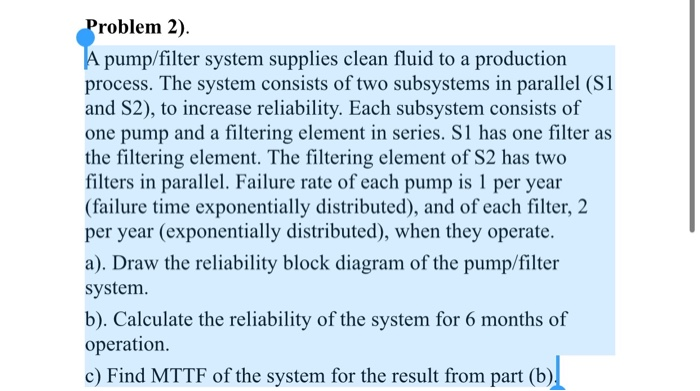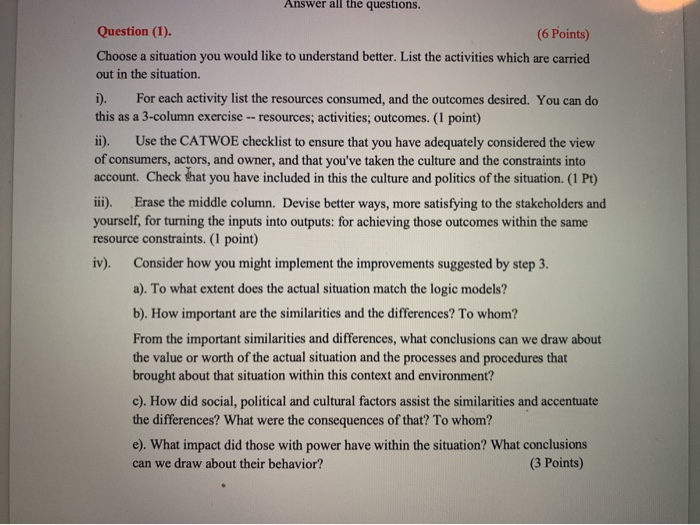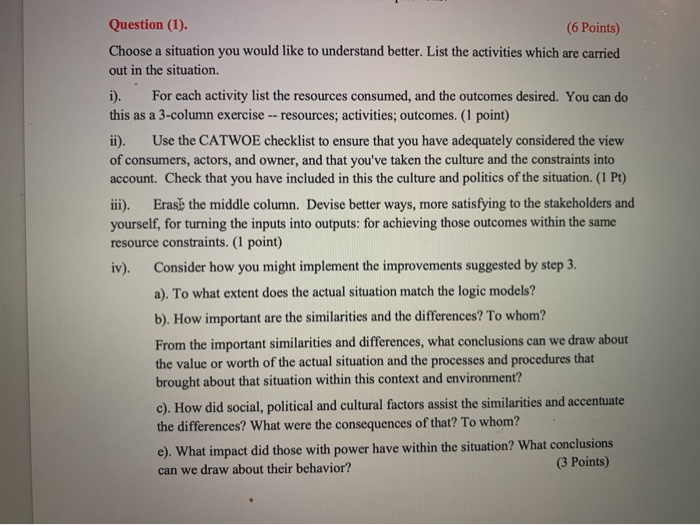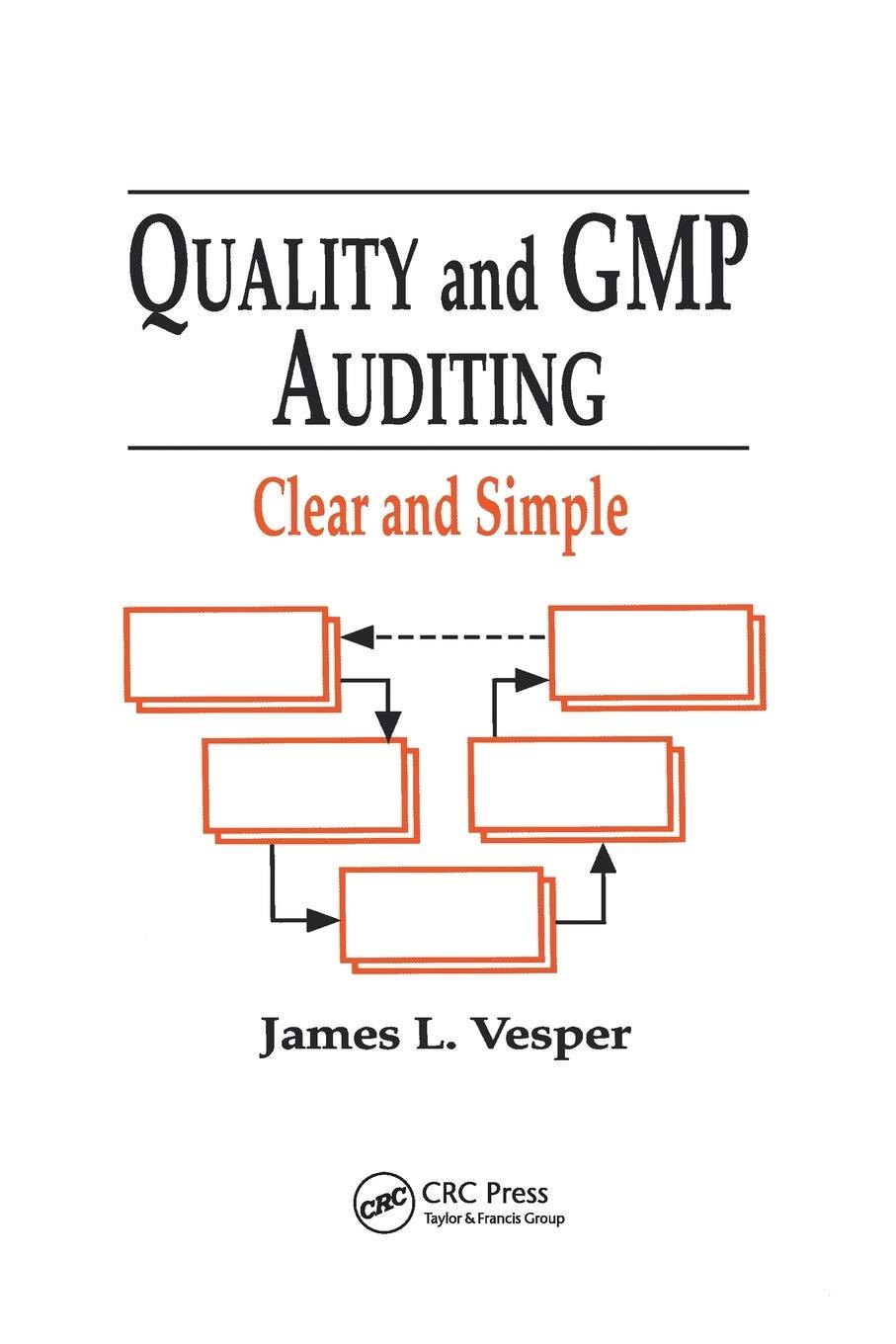Problem 2). A pump/filter system supplies clean fluid to a production process. The system consists of two subsystems in parallel (S1 and S2), to increase reliability. Each subsystem consists of one pump and a filtering element in series. Si has one filter as the filtering element. The filtering element of S2 has two filters in parallel. Failure rate of each pump is 1 per year (failure time exponentially distributed), and of each filter, 2 per year (exponentially distributed), when they operate. a). Draw the reliability block diagram of the pump/filter system. b). Calculate the reliability of the system for 6 months of operation. c) Find MTTF of the system for the result from part (b). Answer all the questions. Question (1). (6 Points) Choose a situation you would like to understand better. List the activities which are carried out in the situation. i). For each activity list the resources consumed, and the outcomes desired. You can do this as a 3-column exercise -- resources; activities; outcomes. (1 point) ii). Use the CATWOE checklist to ensure that you have adequately considered the view of consumers, actors, and owner, and that you've taken the culture and the constraints into account. Check that you have included in this the culture and politics of the situation. (1 Pt) iii). Erase the middle column. Devise better ways, more satisfying to the stakeholders and yourself, for turning the inputs into outputs: for achieving those outcomes within the same resource constraints. (1 point) iv) Consider how you might implement the improvements suggested by step 3. a). To what extent does the actual situation match the logic models? b). How important are the similarities and the differences? To whom? From the important similarities and differences, what conclusions can we draw about the value or worth of the actual situation and the processes and procedures that brought about that situation within this context and environment? c). How did social, political and cultural factors assist the similarities and accentuate the differences? What were the consequences of that? To whom? e). What impact did those with power have within the situation? What conclusions can we draw about their behavior? (3 Points) Question (1) (6 Points) Choose a situation you would like to understand better. List the activities which are carried out in the situation. i). For each activity list the resources consumed, and the outcomes desired. You can do this as a 3-column exercise -- resources; activities; outcomes. (1 point) Use the CATWOE checklist to ensure that you have adequately considered the view of consumers, actors, and owner, and that you've taken the culture and the constraints into account. Check that you have included in this the culture and politics of the situation. (1 Pt) iii). Eraste the middle column. Devise better ways, more satisfying to the stakeholders and yourself, for turning the inputs into outputs: for achieving those outcomes within the same resource constraints. (1 point) iv). Consider how you might implement the improvements suggested by step 3. a). To what extent does the actual situation match the logic models? b). How important are the similarities and the differences? To whom? From the important similarities and differences, what conclusions can we draw about the value or worth of the actual situation and the processes and procedures that brought about that situation within this context and environment? c). How did social, political and cultural factors assist the similarities and accentuate the differences? What were the consequences of that? To whom? e). What impact did those with power have within the situation? What conclusions can we draw about their behavior? (3 Points) Problem 2). A pump/filter system supplies clean fluid to a production process. The system consists of two subsystems in parallel (S1 and S2), to increase reliability. Each subsystem consists of one pump and a filtering element in series. Si has one filter as the filtering element. The filtering element of S2 has two filters in parallel. Failure rate of each pump is 1 per year (failure time exponentially distributed), and of each filter, 2 per year (exponentially distributed), when they operate. a). Draw the reliability block diagram of the pump/filter system. b). Calculate the reliability of the system for 6 months of operation. c) Find MTTF of the system for the result from part (b). Answer all the questions. Question (1). (6 Points) Choose a situation you would like to understand better. List the activities which are carried out in the situation. i). For each activity list the resources consumed, and the outcomes desired. You can do this as a 3-column exercise -- resources; activities; outcomes. (1 point) ii). Use the CATWOE checklist to ensure that you have adequately considered the view of consumers, actors, and owner, and that you've taken the culture and the constraints into account. Check that you have included in this the culture and politics of the situation. (1 Pt) iii). Erase the middle column. Devise better ways, more satisfying to the stakeholders and yourself, for turning the inputs into outputs: for achieving those outcomes within the same resource constraints. (1 point) iv) Consider how you might implement the improvements suggested by step 3. a). To what extent does the actual situation match the logic models? b). How important are the similarities and the differences? To whom? From the important similarities and differences, what conclusions can we draw about the value or worth of the actual situation and the processes and procedures that brought about that situation within this context and environment? c). How did social, political and cultural factors assist the similarities and accentuate the differences? What were the consequences of that? To whom? e). What impact did those with power have within the situation? What conclusions can we draw about their behavior? (3 Points) Question (1) (6 Points) Choose a situation you would like to understand better. List the activities which are carried out in the situation. i). For each activity list the resources consumed, and the outcomes desired. You can do this as a 3-column exercise -- resources; activities; outcomes. (1 point) Use the CATWOE checklist to ensure that you have adequately considered the view of consumers, actors, and owner, and that you've taken the culture and the constraints into account. Check that you have included in this the culture and politics of the situation. (1 Pt) iii). Eraste the middle column. Devise better ways, more satisfying to the stakeholders and yourself, for turning the inputs into outputs: for achieving those outcomes within the same resource constraints. (1 point) iv). Consider how you might implement the improvements suggested by step 3. a). To what extent does the actual situation match the logic models? b). How important are the similarities and the differences? To whom? From the important similarities and differences, what conclusions can we draw about the value or worth of the actual situation and the processes and procedures that brought about that situation within this context and environment? c). How did social, political and cultural factors assist the similarities and accentuate the differences? What were the consequences of that? To whom? e). What impact did those with power have within the situation? What conclusions can we draw about their behavior? (3 Points)









